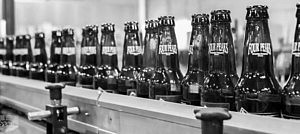What it takes to take the OG Nope, we’re not talking about Snoop or Montell Jordan here! We’re talking about Original Gravity and its impact on the beer in your hand.
In his book, Tasting Beer: An Insider’s Guide to the World’s Greatest Drink, Randy Mosher describes gravity as “the density of wort or unfermented beer and is simply a way of saying how much sugar and other dissolved solids are contained in the beer.”
Our favorite little brewers (yeast!) love sugar. In fact, yeast needs sugar, so they can gobble it up to make two things: alcohol and CO2. Just remember, brewers make wort; yeast make beer! This is evident in the alcohol content of the brew in your hand and the blue buckets that sit next to the fermentation vessels. (Stop by for a brewery tour sometime so you can get up close and personal with them.)
The OG can be an indicator of what the ABV (alcohol by volume) range could be as it gives a numerical value for the volume of fermentable sugars in the wort. (Wort is what the liquid is called before it is fermented, or before yeast is introduced to it to break it down into a brew.)
A hydrometer and refractometer are tools that are used to measure the gravity of the wort before it’s fermented (get it? Original Gravity?!). When the gravity is taken after fermentation, it’s called Terminal Gravity, or TG. At Four Peaks, gravity measures, taken in º P, are measured frequently – as frequently as possible. When I asked Brewer, Bob Grayson, why we take gravities so often he explained that it’s a good practice to ensure we are maintaining the right track for the ABV we are shooting to achieve. Once the gravity reading reaches the gravity range that we are looking for, the temps are turned down on the tanks and the yeast are suspended in a post-Thanksgiving like nocturnal slumber then removed.
Yeast is a colony of living cells, and sometimes these cells act out on their own. Yeast activity may depend on the life cycle of the yeast, the generation, the strain of yeast, its environment (is it too hot or too cold) – especially the health of the yeast. Our labs test for these factors before we “pitch” (a fancy word that means introduce or add) the yeast to the wort.
The ABV calculation takes into consideration both the OG and the TG. Once your measurements for the OG and the TG are taken, it’s plug and play. (Caution: math ahead!)
ABV% = (1.05/0.79)* x ((OG – TG) / TG) *1.05 is the number of grams of ethanol produced for every gram of CO2 produced, and .79 is the density of ethanol.
For example:
If the first gravity for a brew is measured out to be 15º P and the last gravity measured out to be 2.6º P, the formula for figuring out that particular brew’s ABV would look like this:
6.3%=(1.05/.79) x ((15-2.6)/2.6)
For a beer that starts at a lower gravity, say, 10º P and finishes at the same gravity as the first example, the equation would work out to:
3.9%=(1.05/.79) x ((10-2.6)/2.6)
Looking at the math, one can understand to some degree how big beers get big and sessionable beers remain… sessionable. Lots of sugary wort with healthy and active yeast will yield a higher ABV. If wort doesn’t have a lot of sugar to begin with, it won’t have as much to offer to the yeast to process, ergo the yeast won’t have the opportunity to produce more alcohol.
Whew! Well there you have it – you now know a little more about the OG than you may have planned at the beginning of your day. I hope you found this teachable moment fun(ish) and enlightening! At the very least, you can use it to impress your friends or win a round of Bar Trivia!
Have questions about OG, TG, or brewing in general? Hit us up on Twitter!
Want to learn more? Join us for a brewery tour! Get more details at www.fourpeaks.com!
Share:Original Source Here

